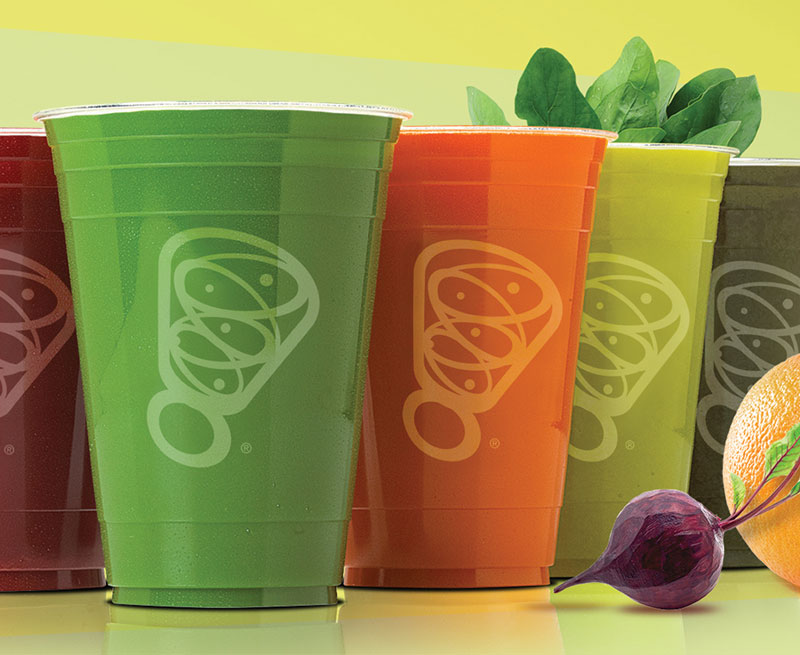Frank Easterbrook, president and CEO of Juice It Up!, is passionate about juicing. So much so that he wants to reverse the ratio of smoothies to juices sold at Juice It Up! so that juices dominate the business.
Fresh raw juices, introduced about a year and a half ago, account for 15 percent of sales at the California-based store.
“Realistically, I’d like to see it get to 50-50,” Easterbrook says. “With my interest in the health and wellbeing of people, however, I’d personally like to see it at 85 percent juice.”
Juicing—extracting juices from fruits and vegetables—can be a hassle to do at home, Easterbrook says. This creates a niche for Juice It Up! to provide the service for serious juicers.
Raw juicing is more labor-intensive than smoothie making, and Juice It Up! franchisees have invested $10,000 in what Easterbrook calls “a modest retrofit with new equipment and a modified layout to achieve efficiencies.”
The Juice it Up! menu offers 100 percent orange, carrot, and apple juices, plus seven raw juice combinations, such as The Refresher, with pineapple, cucumber, celery, and lemon. The Awakener combines orange and apple juices with ginger, and The Energizer consists of juice from red grapes, pineapple, spinach, and ginger.
Juice It Up!
President & CEO: Frank Easterbrook
HQ: Irvine, California
Year Started: 1995
Annual Sales: $25 million
Total Units: 90
Franchise units: 87
“It’s all about feeling better,” Easterbrook says of juicing. “It’s all fresh and all raw and juiced in front of the customer.”
But Juice It Up! hasn’t turned its back on smoothie lovers, who have their pick of 24 varieties. “We have a loyal group of customers who want smoothies,” Easterbrook says. “From youngsters who want the sweet Strawberry Wave made with yogurt, banana, and strawberries, to weightlifters and runners who are looking for something high in protein.”
For that workout crowd, Juice It Up! offers choices like The Zone, which blends nonfat yogurt, banana, peanut butter, peanuts, and protein powder.
An average ticket at Juice It Up! is $6.50, and the stores also offer pretzels, health bars, and breads. Easterbrook says it’s experimenting with in-store prepared items like panini sandwiches, too. But most Juice It Up! customers are content having a smoothie or juice as a meal.
“We cover a lot of dayparts,” Easterbrook says, noting that some customers replace breakfast or lunch with a smoothie or juice, while others come in for an afternoon pick-me-up. Evenings attract families with kids and young people, who like to hang out and have smoothies.
Easterbrook says making handcrafted smoothies with whole frozen fruit rather than concentrated purée drives prices up somewhat. “The smoothies we offer are a high-quality product and the core of our business,” he says.
The brand was started by two California State University, Fullerton graduates, and by 1999, it had 25 locations. Easterbrook was an investor and became principal shareholder in the chain in 2001.
Between 2004 and 2008, the brand had 180 locations. Then the economy fell apart. “We went through a downturn in the economy and people had to focus on nondiscretionary things,” Easterbrook says. Smoothies were no longer in many consumers’ budgets, and almost half of the Juice it Up! locations closed between 2008 and 2010. In the last year, however, juicing’s popularity has led to growth in remaining stores.
“People who juice have been doing it for a long time and do it practically every day,” Easterbrook says. “The juice customers we have will come here three to five times a week. Smoothie customers come only once or twice a week.”
He says the brand has seen 20 percent year-over-year, same-store growth in 2012. Three stores were added in 2012, and Juice It Up! is targeting 12–15 new stores in 2013. It is in four states, with the majority of stores located in California, but Easterbrook says he is reaching out to potential franchisees in Midwestern and Southern states.
Juice It Up! has stores inside malls, on college campuses, and in strip-shopping centers, and it sells a line of light smoothies in several school systems.
“Our catering program goes into schools during the school day and after school,” Easterbrook says. “And we give a third of those sales back to the schools.” He says a typical Juice It Up! store is about 1,000 square feet, inline, end cap, or in a shopping center.
“People walking past experience the smell of fresh fruits and veggies, and that excites them to try and buy,” Easterbrook says. “Our focus is on the health aspects of juicing, but it also has to be on taste. If people don’t like the taste of something, they aren’t going to order it, no matter how healthy it is.”








